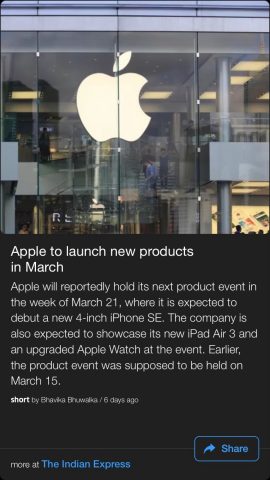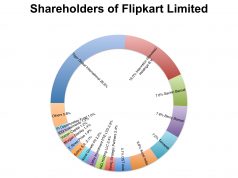Since January of 2016, every time I used the mobile Twitter app, about 3-4 times a day, I have been seeing a promoted tweet from the news-app startup Inshorts. The app's unique feature is that they rewrite news items from other sources into summaries of 60 words or less, with a link to the source. The app has garnered a lot of press attention and the founders have been featured in several lists of "people to watch."
 I recently spoke to Inshorts co-founder Deepit Purkayastha in an interview that covered the ad campaign and then moved on to the company's growth, editorial process and business plan.
I recently spoke to Inshorts co-founder Deepit Purkayastha in an interview that covered the ad campaign and then moved on to the company's growth, editorial process and business plan.
Campaign
Tell me about your campaign. What are it's goals, why are you running this now?
It is a 2-fold exercise, first to understand our users, and second, to drive customer acquisition. We are trying to understand, after experiencing the product, how long do they stay? Then we are doing a bit of experimentation with what kind of users find value with Inshorts the most. We are doing demographic
profiling, looking at active Twitter users and active Facebook users. We do not plan to scale this further, as soon as we know the results.
Growth
Let's talk about your growth. How many employees do you currently have?
We have a 70 member team. About half is in editorial, the remaining in business functions.
Back in July of 2015 news reports said that Inshorts would hire over 100 content writers by years end?
We found that we do not need a lot of editors to do what we need to do. We have found ways to increase the productivity of editors. We have also entered into content partnerships to grow content. The partners provide us with summaries.
We also realized that finding and grooming the right kind of talent is very important. We don't want to rush it.
Has growth stalled? The news reports also said you expected to have 5 million downloads by year's end. But it seems you still only have 3 million.
We are touching 4 million downloads now. We are exploring a lot of acquisition channels to get users. Some audience segments have worked really for us and some have not.
Downloads isn't the only important metric. The last 6 months we have grown 15 times in the number of screen views. Since the beginning of last year, that's grown about 30 times. So engagement has increased, attention has increased.
We are exploring other geographers and vernacular. After Hindi what comes next is still not settled.
Criteria for selecting another language: Potential market for the language or geography. How big is that opportunity, right time to enter that market, do they want to consume news? A lot depends on the demographics of the user as well.
Is there any economies of scale in adding languages?
If geography is the same. The personalization engine will work commonly in all languages and geographies.
There is a time lag in a story being covered in one language to another. Breaking news stories, we do sometimes link to an English article.
Aren't you dependent on how much content is available in the local language?
I think that there will be an increasing number of content creators in vernacular.
How will you know whether newly formed sources are reliable? They may not have a reputation like currently established news sources.
That is a problem that needs to be solved.
"We would not do any disclosure that it's being shown to you because it's being paid for."
Editorial
How do you pick the news articles?
Our editorial process is based on two aspects. First, editorial policy evolves by understanding what content, format and information is working for our users, and what kind of users we get. That is driven by data. The second aspect is operational. We try to see the informativeness of news. Lot of stories do not inform users of anything extra beyond what he already knows. We try to present something concrete which is new information for users.
Of course this depends on human judgement. We do have some indicators in place. It might seem counterintuitive, but what works is not so different for different people. Also, users didn't demand that many stories. Earlier, users used to tell us we didn't have enough stories. After we started doing 150 stories a day, most users don't complain about what they are getting.
Are you trying to cater to everyone's tastes, or only to some subgroup?
The kind of audience we have are not news junkies or experts of any one field. They are pretty homogenous. It's
people who are not into the habit of reading news and are just starting to consume news. They do not have a lot of context for many stories. It is primarily a young audience, 18-22 year old college students.
Won't they then move away from Inshorts as they age or seek more depth in their articles?
We believe the 18-34 year old readers will evolve into 18-45 year old smartphone users. I wouldn't say they want more than 60 words, they want 60 words that match up to their expectations.
Do you ever see the 60-word limit changing?
No, that is something that is really core. That is 3 sentences.
Does that hold true for other languages as well?
Definitely holds for all Indian languages. I don't know about Chinese.
Will sponsored content also be limited to 60 words?
Yes.
Will it be flagged as paid content?
Our stories are only information. We don't provide opinion. Therefore the content is informative in itself. We would not do any disclosure that it's being shown to you because it's being paid for.
Don't you think that raise a red flag with people?
I do not think this will bring up red flags with people. People have consumed a lot more of those compared to news stories themselves.
Are you saying you have already presented paid content?
We do movie trailers. We have done movie trailers. We have not done monetization, but we have done experimentation around it. If readers are interested in that, why do we need to say whether it was sponsored?
You recently created a video. Is that a new direction for you?
You mean the video with factly? Actually that was another way to raise attention, partnering with them.
So Inshorts will remain text only?
Yes. That said, we are well position to distribute informative video content as well. However at the moment data bandwidth and smartphone penetration doesn't support it.
Do you have content licensing agreements with all your sources?
Let me clarify that to write 60-word summaries we do not need to get into content agreements for us. That said, we do have some agreements with a few sources. We have partners who write summaries for us.
Do those sources receive compensation?
Currently there is no commercial transaction.
You are saying that there are sources who provide you with content, even 60-word summaries, for free?
We do have one or two sources that are compensated. We are currently exploring different content partner strategies. Saying anything more right now would be premature.
What is the benefit to the content providers? Aren't you taking away their traffic?
Once a person reads a summary, if they click on the link, the providers get traffic. When a user comes their site from elsewhere, there is a high bounce rate, they don't completely read the full article. When a person goes from our summary through our site, they read the entire article. The value of each click is much higher.
User behavior
What metrics do you collect? How many cards on average does a person read?
We collect all data about how the user is behaving in the app. That includes time per article, the number of times that he clicks the link to the full article, whether he shares or not.
So can you share some of the data that have you seen?
On average a user spends about 10 secs per article. A daily active user (DAU) browses through 80-100 screens. If we say that it takes 20 secs to read an article, then they are reading 50% at least.
How many times do people click through to the source article?
It is between 1-5%. It varies a lot from article to article, whether the source is from videos or full text stories. The average rate won't be a good indicator.
What gets a high click through?
That is something that we are working on.
Do they come back after they've read the source?
Clicking through happens in the app itself. It's in the behavior to come back.
"We are trying to change the existing aggregation models. Right now many aggregators aggregate content from a particular source, capture brand loyalty of that source."
Business Model
In early Feb Azhar was quoted as saying InShorts is not even thinking about monetization, then 2 weeks later there's news that you're trying to secure a revenue stream.
There has been a lot of confusion about this, and we have tried to clarify. We are not currently focusing on the revenues. We are doing experiments around content that can have commercial intent around it. Whether it can be engaging enough for users. Unless users engagement with the piece of content is really important, if the user doesn't find value even with commercial content, then we would not want to show that piece of content to users. We would want to maintain neutrality between content that has commercial intent and that which doesn't.
What if news outlets start erecting paywalls?
Our product experience very uniquely fits into paywalls. You can read the summary and as soon as you want to read the full article, there could be an integrated wallet.
How the product will evolve and how the
We would want to become the default news app on everyone's phones. The goto market strategy may not be the complete market in itself.
At a time when news organizations are struggling to stay profitable, if your model took off, you would need to cover your own costs, and their costs. Is that feasible?
Yes. Here is why we think that. It may sound ambitious, but there are two fundamental keystones of how we're building this.
First, [content creators are having difficulty in keeping afloat in content creation.] Their core strength is in creating content, but not in personalization, packaging, user experience and technology. We would act as enablers for them in this space. Content creator can't be doing this every time.
Second, we are trying to change the existing aggregation models. Right now many aggregators aggregate content from a particular source, capture brand loyalty of that source. Publishers should start distributing not as the whole package itself, but as smaller packages themselves. This is what marketing leaders around the world are saying. That way they increase reach of a particular piece of content.
You're the Netflix of news?
Yes.
How are you different from Circa in terms of product, audience? How will you avoid the same fate?
What has worked for us differently from Circa, people in a certain demo have stuck on to our product and gotten into the habit of reading the news. Circa was a very evolved segment. Our product offering has a much more mass appeal than Circa. Circa was going into the depths of each news story.
Everyone's trying to perfect the news feed, including Facebook. Do you hope to beat them?
[Laughs] Same question been put to startups, "How will you succeed in the face of competition from big established companies?"
We believe that because of our focus and understanding of content consumption, we will defeat them in the innovation curve.
Essential difference is that once a person goes to Facebook and spends an hour on Facebook, he doesn't feel very productive. A person who spends 20-30 minutes on our site feels productive. Facebook has photos, comments and more. We have taken a contrarian view. We have kept it focused and simple.
Please like NewsPie's page on Facebook so that you get all our articles and others may find us.







